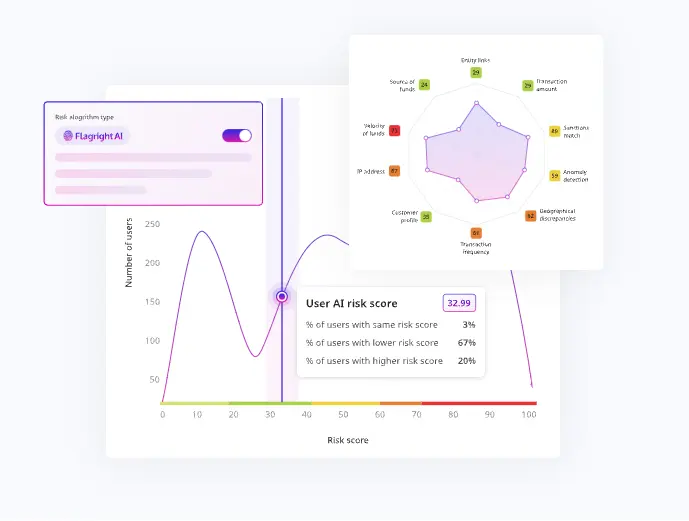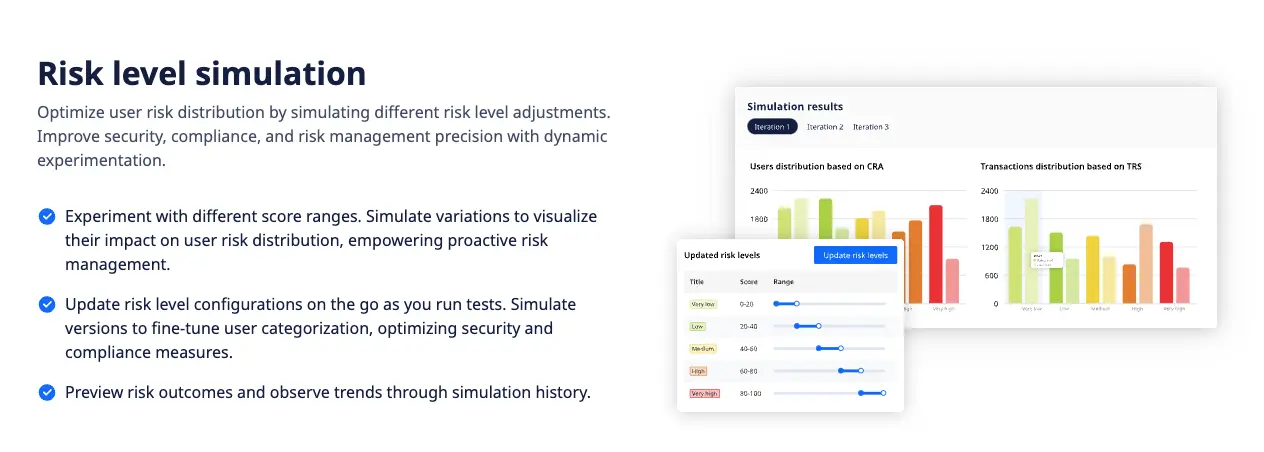Understanding and managing customer risk is not only a regulatory obligation in the quickly changing fintech world, but also a strategic one. As financial technology evolve and the amount of digital transactions rises, fintechs face new hurdles in preventing financial crimes and ensuring regulatory compliance. However, behind these hurdles comes a major opportunity: enhancing customer trust and establishing a sustainable company.
Customer risk assessment is critical for detecting possible threats before they occur, allowing fintechs to minimise risks proactively. This procedure entails analysing customer data to identify unexpected trends that could signal fraud, money laundering, or other financial risks. Fintechs can not only meet the demanding demands of global compliance standards by effectively analysing and managing customer risk, but also provide a safer and more reliable service to their customers.
In this post, we'll look at why prioritising customer risk assessment is critical to the long-term success of fintech organisations. We'll look at how incorporating advanced financial assessment tools, such as those provided by Flagright, can enhance transaction monitoring systems, automate and refine risk evaluation procedures, and eventually revolutionise the landscape of financial security and customer confidence. Let's look at the crucial role of customer risk assessment in creating the future of fintech operations and ensuring their success in a competitive and regulated environment.
Understanding Customer Risk Assessment
Customer risk assessment is a key procedure used by fintechs and other financial institutions, including banks, to determine the possible risk of engaging with each customer. This assessment is important for determining which customers pose higher fraud, money laundering, or other illegal activity risks. Fintechs can tailor their approach to monitoring, servicing, and managing risks associated with distinct customer profiles by analysing multiple data points about a customer's behaviour, transaction patterns, and background.
Role in Fintech Operations
In fintech operations, customer risk assessment serves multiple critical functions:
- Regulatory compliance: Ensures that the company abides by anti-money laundering (AML) legislation, Know Your Customer (KYC) requirements, and other financial regulations intended to prevent and identify financial crime.
- Fraud prevention: Assists in detecting potential fraud before it occurs by identifying signals of suspicious behaviour based on each customer's risk profile.
- Customised customer experience: Enables fintechs to provide customised products or services based on customer risk level, enhancing customer satisfaction and engagement.
The Dynamic Nature of Risk Factors

Risk considerations in the fintech business evolve as new financial products emerge, regulatory landscapes move, and criminals devise new ways to exploit system weaknesses. As a result, fintechs must regularly update their risk assessment criteria and techniques to stay up with these changes. This continuous modification is critical to the continued effectiveness of risk management systems.
Adapting to Evolving Risk Landscapes
To effectively adapt to changing risk landscapes, fintechs should examine the following approaches:
- Continuous monitoring: Set up systems that continuously monitor customer behaviours and highlight transactions that deviate from regular trends.
- Data-driven insights: Use big data analytics and machine learning algorithms to improve risk assessments based on real-time data. This approach aids in the detection of minor patterns and correlations that may suggest impending risks.
- Collaborative information sharing: Join industry consortiums and networks where businesses share knowledge on emerging types of fraud and effective prevention strategies. This collaboration has the potential to enhance the fintech ecosystem's collective ability to respond to new threats.
Fintechs safeguard themselves and their customers from potential financial crimes by understanding and implementing comprehensive customer risk assessment processes. They also establish themselves as trustworthy and reliable partners in the financial sector. As risk landscapes evolve, the ability to adapt and respond with sophisticated risk assessment tools will determine the success and resilience of fintech operations.
Integration with Transaction Monitoring
Customer risk assessment and transaction monitoring are two critical components of a comprehensive risk management plan for fintech operations. When effectively integrated, these systems work together to provide a dynamic and responsive approach to detecting and preventing financial crime.

Seamless Integration for Enhanced Security
Integrating customer risk assessment with transaction monitoring systems entails utilising the insights gathered from initial risk assessments to inform and fine-tune the monitoring algorithms. This integration enables the transaction monitoring system to operate not only on established criteria, but also adjust its sensitivity based on the risk levels associated with each customer.
- Risk-based monitoring: This approach tailors monitoring intensity and alert types based on individual customers' risk profiles. High-risk customers may be subjected to stricter monitoring and additional inspections, whereas low-risk customers benefit from easier transaction processes, reducing unnecessary friction.
- Dynamic adjustments: As customers' behaviour changes over time or as they interact with different items, their risk levels may shift. Integrated systems have the ability to dynamically adjust monitoring parameters in real time, enhancing the system's ability to detect suspicious activity precisely.
Benefits of Integration
The integration of customer risk assessment with transaction monitoring systems has several key advantages:
- Improved fraud detection accuracy: By integrating transaction monitoring with individual risk profiles, fintechs can reduce false positives and negatives. This raises the efficiency of the investigation processes and improves the accuracy of fraud detection.
- Enhanced compliance capabilities: This integrated approach ensures that monitoring activities are consistent with regulatory standards, which frequently require risk-based approaches to AML and fraud prevention. It helps fintechs to show authorities that their monitoring systems are smart and tailored to actual risk levels.
- Operational efficiency: Fintechs can spend their investigative resources more effectively by prioritising risk and attention based on risk. While higher risk transactions receive the scrutiny they require, lower risk transactions run more smoothly, enhancing the customer experience.
- Real-time response: Integrated systems can adjust monitoring parameters and update risk assessments in real time based on fresh data. In a fast-paced financial industry where delays can result in severe exposure to fraud and other financial crimes, this skill is important.
The integration of customer risk assessment with transaction monitoring systems is a proactive, intelligent risk management approach. It not only ensures that fintechs remain ahead of potential threats, but it also optimises their operations to balance security and customer happiness. By utilising this integrated approach, fintechs may navigate the complexity of the financial sector with better confidence and compliance.
Benefits of Automating Customer Risk Assessments
Automating consumer risk assessment is not just convenient, but necessary to maintain operational efficiency and competitive advantage in the complex and fast-paced world of fintech. For risk management operations, using sophisticated automated systems like Flagright's dynamic scoring engine offers several strategic advantages.
Key Benefits of Automation
- Consistency and accuracy: Automated systems have a consistent approach to risk assessment, applying the same criteria and calculations to all customer interactions. This uniformity helps to reduce human errors that can arise in manual assessments, such as oversight or subjective judgement, hence boosting the accuracy of the risk profiles created.
- Scalability: As fintechs grow, the number of customers and transactions tends to increase rapidly. Automated risk assessment systems can manage massive amounts of data and assess several customer profiles at the same time without compromising performance. This scalability is critical for expanding operations while maintaining high monitoring quality and compliance standards.
- Speed: Automation enables the fast processing of data as it is received. Flagright's dynamic scoring engine, for example, can rapidly create risk scores based on real-time data, offering critical insights for timely financial decisions.
- Integration with other systems: Flagright's automated risk assessment technology is easily integrated with other monitoring and management systems. This integration provides a seamless flow of information between platforms, enhancing the framework's overall risk management efficiency.
- Dynamic updating: Automated systems can be set up to update risk factors and ratings based on the most recent test data trends and analysis. This dynamic updating promotes proactive risk management by adapting to new threats as they emerge and refining the system based on performance and feedback.

Improving Efficiency and Enabling Risk-Based Monitoring
Automation improves operational efficiency by reducing the workload for human analysts. This efficiency enables risk management teams to focus on strategic analysis rather than mundane data processing, resulting in more informed judgements.Furthermore, automated customer risk assessment enhances risk-based monitoring, which allocates resources based on the risk levels of various customer segments. This approach enables fintechs to prioritise high-risk instances, which may require more extensive monitoring and rapid intervention, while applying less severe controls to lower-risk cases, thereby optimising operational resources and enhancing customer experience.
Customisation and Flexibility in Risk Management
In the broad world of fintech, where business models and customer bases can vary greatly from one company to the next, the ability to customise and adapt risk management systems is crucial. Customisation ensures that risk assessment tools are effectively linked with individual operational requirements, whether serving B2B or B2C customers.
Customisable Features of Risk Assessment Tools
Risk assessment tools with customisable features enable fintechs to tailor their approaches based on their own business models and the distinct risks associated with different customer categories.
- Risk algorithm customisation: Fintechs can change the parameters and thresholds in their risk algorithms to better match their customers' risk profiles. For example, a B2B fintech dealing with huge transactions may have different thresholds for suspicious activity than a B2C app focused on microtransactions.
- Custom scenarios: Depending on the nature of transactions and customer interactions, fintechs may develop custom scenarios within their risk models to address industry-specific threats. These scenarios can be tailored to detect fraud in real-time payments, monitor remittances for unusual patterns, identify laundering risks in high-value transfers, or flag unusual activity involving payment processors for enhanced compliance and security.
- Dynamic scoring models: Real-time data inputs can be used to dynamically adjust risk scores based on current customer activity or developing threat trends. This flexibility is critical for risk assessment accuracy.
The significance of flexible, customisable risk algorithms
The financial sector is characterised by fast change and shifting regulatory landscapes. Flexible and customisable risk algorithms are important for various reasons:
- Addressing multiple customer needs: Fintechs cater to a diverse spectrum of customers, each with unique behaviours and risk considerations. Customisable algorithms allow fintechs to fine-tune their risk assessment processes in order to effectively manage the individual risks associated with various customer groups.
- Adapting to regulatory changes: Financial regulations differ by jurisdiction and evolve over time. Flexible risk management technologies enable fintechs to quickly adjust their systems to ensure compliance with new or amended rules.
- Improving response to emerging threats: Innovative fraud schemes continue to challenge the financial sector. Customisable risk management technologies assist fintechs in responding quickly and effectively to these threats by allowing them to adjust their risk parameters and deploy additional detection scenarios as needed.
Implementation Considerations
Implementing customisation and flexibility in risk management requires various considerations:
- Technology infrastructure: Make sure the underlying technology can handle substantial customisation and real-time processing. This could include investing in innovative software platforms or cloud solutions that provide scalability and adaptability.
- Expertise: Customised risk management systems require expertise in risk analysis, machine learning, and compliance. Fintechs should explore building this expertise in-house or collaborating with specialised vendors such as Flagright.
- Continuous monitoring and testing: Monitor the effectiveness of customised risk settings on a regular basis and test them periodically to ensure they continue to be effective against actual risk scenarios. This approach aids in the ongoing refining of risk models.
Fintechs may ensure that their approaches stay resilient, relevant, and responsive to the fast-paced financial world by embracing customisation and flexibility in their risk management techniques. This adaptability protects them not only from present risks, but also prepares them for future difficulties, ensuring long-term operational resilience and compliance.
Simulating Risk Levels for Proactive Management
Simulating risk levels is essential in the proactive management of financial risks. This sophisticated method entails employing risk simulation tools to generate hypothetical scenarios based on various risk factors and possible customer behaviours. Fintechs may fine-tune their risk management methods by understanding the possible consequences of these scenarios, ensuring that they are both successful and compatible with regulatory standards.
Importance of Risk Level Simulation
Risk level simulation enables fintechs to predict and plan for potential risks before they occur. This proactive approach has numerous important benefits:
- Enhanced preparedness: Simulations assist in identifying potential vulnerabilities in the risk management system, allowing fintechs to make necessary adjustments ahead of time.
- Optimised risk mitigation tactics: By testing various risk scenarios, fintechs can determine the most effective strategies for managing specific types of risks.
- Regulatory compliance: Simulating risk scenarios on a regular basis can also assist ensure that risk management processes are in line with the latest legislation, since it allows businesses to check their readiness for regulatory audits.

How Fintechs Can Use Risk-Level Simulation Tools
Fintechs can use risk level simulation tools to enhance their risk management operations in numerous ways:
- Scenario analysis involves creating and analysing scenarios based on both usual and atypical customer behaviours that may signal higher risk levels. Simulating transactions from high-risk geographic locations or unusually large transfers, for example, can aid in the identification of potential weaknesses in monitoring systems.
- Use simulations to test the impact of modifying risk thresholds on the overall efficiency of the risk management system. This can assist determine the best parameters for recognising real risks without overwhelming the system with false positives.
- Stress testing systems simulate severe conditions, such as unexpected increases in transaction volume or new forms of fraud strategies, to assess the strength of existing risk management frameworks. Stress testing ensures that the system can deal with unforeseen conditions effectively.
- Implement technologies that enable for dynamic updates to risk models based on simulation results for dynamic risk management. This adaptability is critical for keeping up with emerging financial threats and regulatory frameworks.
- Combine simulation tools with real-time data streams to constantly update and refine risk scenarios based on current transaction data and emerging patterns. This integration ensures that the simulations remain relevant and closely related to actual operational situations.
Implementing Risk Level Simulations
To effectively implement risk level simulations, fintechs should:
- Invest in advanced simulation software: Select a software that includes complete functionality for developing, managing, and analysing risk simulations. Exactly what Flagright offers.
- Collaborate across departments: To develop a cohesive approach to risk management, ensure that insights from simulations are communicated across compliance, risk management, and operational teams.
- Regular reviews and updates: Simulation models should be reviewed and updated on a regular basis to incorporate new data and operational changes.
Fintechs can considerably enhance their ability to effectively manage risks by proactively simulating various risk levels. This not only increases their defences against potential financial crimes, but it also improves their reputation for dependability and compliance, which is essential for long-term success in the competitive financial sector.
Conclusion
Effective customer risk assessment is more than just a compliance need; it is a critical component of modern fintech operations, affecting a company's ability to operate securely and successfully in a competitive financial climate. As previously discussed, the integration of advanced risk assessment strategies—ranging from employing dynamic and customisable risk tools to simulating risk scenarios—provides fintechs with the agility and precision required to manage the intricacies of today's financial threats.
The implementation of such advanced processes ensures that fintechs may not only meet, but surpass, regulatory requirements, avoid fraud, and improve customer experience. Fintechs prepare themselves to confront both present and future difficulties by embracing flexible, scalable solutions for risk management, securing their operations and enhancing their market position.
For fintech leaders looking to enhance their understanding of risk assessment and strengthen their strategies, Flagright can help you navigate the complexities of the financial sector with confidence and compliance. Flagright provides cutting-edge technologies that are essential for modernising risk management procedures. Our solutions are intended to give accurate risk assessments, connect easily with existing systems, and provide the adaptability required to prosper in a continually evolving business.
About the Author
Joseph Ibitola leads global demand generation at Flagright, an AI-native transaction monitoring and AML compliance platform. He drives marketing strategy, campaigns, and growth initiatives that help financial institutions adopt stronger compliance frameworks and reduce fraud risk. With expertise spanning fraud prevention, AML compliance, and financial risk management, Joseph also develops thought leadership and educational resources that position Flagright as a trusted partner to the finance industry.




.svg)






.webp)














